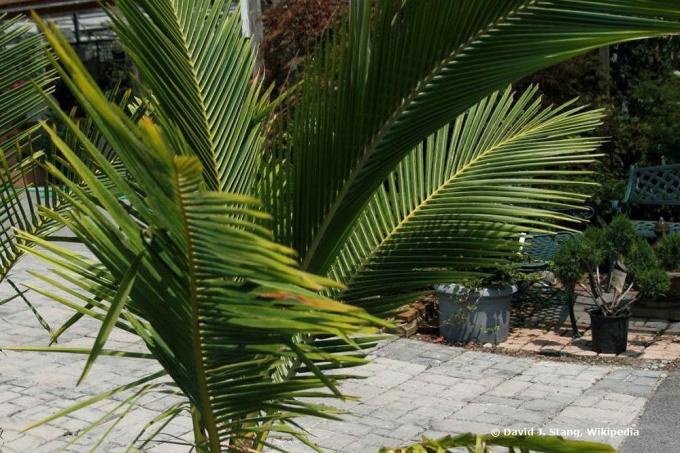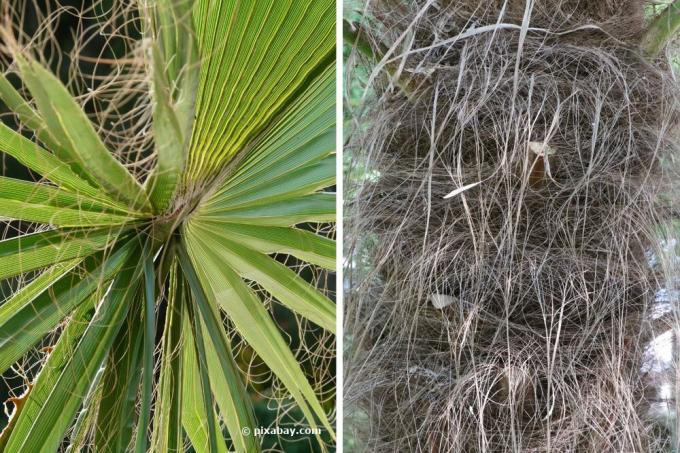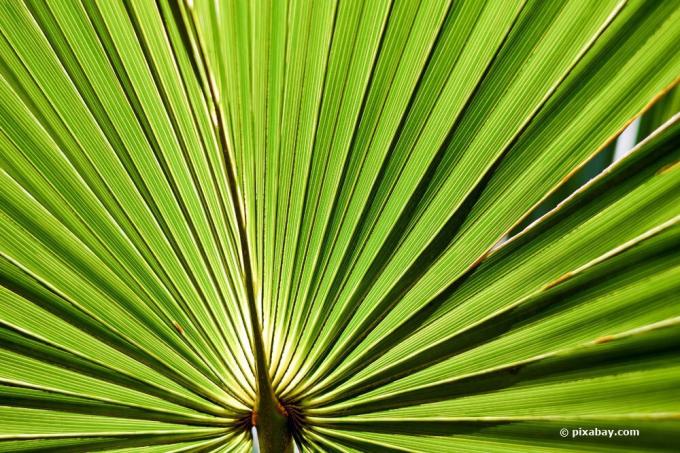
table of contents
- Difference between frost and winter hardy
- Frost hardy
- Hardy
- Hardy and frost-resistant palms
Palm trees create a Mediterranean flair and exude a holiday feeling in the garden that balcony owners don't have to do without. But do the palm trees, which are mostly used to the warm climate, survive the winter? Yes, because there are hardy palms. But be careful, because many palm trees are also offered as frost-resistant. That is not the same. The decisive factor is the minus temperatures up to which palm trees can survive without damage. A list makes the selection easier.
Difference between frost and winter hardy
Palm trees for gardens and balconies are often marked with a sign "hardy or frost-resistant". Most plant lovers assume under both terms that they can safely let their palm spend the winter outdoors without special precautions. If winter shows its coldest side, however, it becomes clear where the difference between frost and winter hard lies. Such palms, which no longer thrive in the following spring, usually have severe symptoms of frostbite because they are / were “only” frost hardy.
Frost hardy
The fundamental difference between frost-resistant and hardy palms is that frost-hardy specimens usually have to take certain precautions to protect them from the cold. Winters are getting colder and colder, so temperatures around -10 ° C are not uncommon. The temperatures of frost resistance are usually around freezing point, down to around -3 ° C or -4 ° C. For too long, the outside temperature should not drop too far below 0 ° C, otherwise symptoms of frostbite can, in the worst case, lead to death.
Cold protection
Especially when a palm tree is planted in a tub, the soil does not offer any special protection from the cold, as is the case in a garden. An insulating pad made of styrofoam or wood is just as indispensable as covering with a jute sack or a fleece. Balconies should be sheltered from the wind and the top layer should be covered with straw, leaves or brushwood. Frost-resistant specimens planted in the garden should also receive winter protection in the event of prolonged cold.
Hardy
The plant expert speaks of a real winter hardiness when palm trees in the usual sub-zero temperatures Withstand central European climes without the need for special protection against the cold or with signs of frostbite is to count. As a rule, the temperature limit for hardy palms in the tub is at least -8 ° C to -9 ° C. They usually tolerate a short-term drop to -13 ° C or -17 ° C without damage. Some bucket palms are even suitable down to temperatures of -20 ° C. They can cope with cold moisture, snow and icy winds.
Hardy and frost-resistant palms
- Blue hesperid palm (Brahea armata)
This palm species originally comes from Central America and is nowadays planted sporadically in the northern Alps. It can be recognized by a solitary, thick and smoothly structured trunk and a bushy palm leaf crown. The palm leaves are mostly gray-silvery in color. It is ideal for cultivating tubs on a balcony or for planting in the garden. It is hardy to -10 ° C.

- Erythea palm (Brahea edulis)
The erythea palm has its origins on the island of Guadeloupe and brings a Caribbean flair to balconies and gardens like no other palm species. Their growth can be severely restricted in pots, because they can reach a height of up to 17 meters with a lot of ground clearance. It is one of the frost-hardy palms with temperatures down to -6 ° C to -7 ° C.
- Blue dwarf palm (Chamaerops humilis var. Cerifera)
This type of palm has its origin in the Mediterranean area. With blue-green fronds, it brings color to balconies and gardens even in winter. It grows with multiple stems and drives out runners. The temperature minimum is -15 ° C. However, prolonged cold weather should not fall below -11 ° C without protection against the cold.
- Chinese hemp palm (Trachycarpus fortunei)
The Chinese hemp palm tops the list of the most popular palm species in Germany. It impresses with its enormous robustness, which also relates to the cold season. Temperatures down to -18 ° C cannot harm her here. The Ticino palm, as it is called in the Alpine regions, is easy to recognize by the "trunk hair", which consists of fine, brown fibers. On balconies and in gardens, it fills the area with a Mediterranean ambience all year round.

- Real date palm (Phoenix dactylifera)
The "real version" is a little more frost-resistant than the Canary Island date palm. The trunk, which in its shape and from a distance is reminiscent of a large pineapple is very striking. Standing in the bucket outside on balconies, the real date palm needs a light to partially shaded location where icy winds cannot pass it. With outside temperatures down to -9 ° C, it copes extremely well even over a longer period of time.

- European dwarf palm (Chamaerops humilis)
The European dwarf palm comes from the western region of the Mediterranean, mainly from Gibraltar. During the summer season it shows itself to be a very easy to care for and robust palm. Just too much moisture can be extremely troublesome for her. This is particularly important in a snowy and / or rainy winter. It is hardy down to -13 ° C, but this assumes that it is quite dry. A winter location under a roof is ideal.

- Himalayan fishtail palm (Caryota maxima)
The Himalayan fishtail palm is characterized by a striking leaf dress that is not typically palm-like appears, but has double pinnate leaves, each of which is joined by additional leaves are. The leaf fronds can reach a length of three meters and a width of two meters. The crown is very densely overgrown. With optimal climatic conditions, up to two meters long fruit clusters form in summer. In winter it can cope with outside temperatures of a maximum of -7 ° C without any problems. It shouldn't get colder without suitable protection against the cold on balconies and / or in the garden.
- Jelly palm (Butia capitata)
This palm species is originally native to South America, especially Brazil, Paraguay and Argentina. The prevailing climate there produces small edible fruits, which is why it is very widespread there. In Central Europe, the pinnate palm grows to a maximum height of five meters, unless there is limited space in a planter. It is one of the frost-resistant palm species and can withstand sub-zero temperatures of around seven or eight degrees Celsius without any problems.

- Green saw palmetto (Serenoa repens green)
The green saw palmetto presents itself with a bushy growth. She likes it partially shaded in summer as well as in winter and ideally with a little sun. When overwintering outdoors, make sure that it is not too damp. If waterlogging forms and temperatures drop below freezing point, the palm can quickly come to an abrupt end. If it is relatively dry on a balcony or terrace, it can withstand temperatures of around -12 ° C undamaged. In the garden bed, the earth usually only freezes superficially, which is why moisture is of no particular importance for the maximum winter temperature of around -15 ° C.

- Honey palm (Jubaea chilensis)
Palms of this kind are among the classics as well as the longest-lived specimens that can easily live to over 80 years. They are quite undemanding and used to the cold from the highlands of their Chilean homeland. It is extremely hardy with temperatures as low as -15 ° C. A light, dry location in the garden or balcony should be given.

- Canary Island Date Palm (Phoenix canariensis)
One of the most popular and well-known palm trees is the date palm, which comes from the Canary Islands. It is mainly cultivated in a bucket and adorns living rooms, balconies and terraces. Due to its frost resistance down to -6 ° C, it is also increasingly finding a location in the garden bed. If the temperatures drop far below -6 ° C, protection from the cold is urgently required, which covers the upper part of the earth as well as the fronds. They shouldn't be hit by drafty, cold winds.

- Cretan Date Palm (Phoenix theophrasti)
This type of palm, which is also native to Turkey, has its source in beautiful Greece. Here it finds a rather mild climate, but it can still cope well with the cold winter temperatures up to a certain degree. If it is planted in the garden, it can survive there down to -15 ° C without special protection against the cold. In a bucket, however, the palms are more sensitive to the cold. If there is less than six degrees below zero, frostbite can occur if there is no protection against the cold.

- Madagascar royal palm (Dypsis decipiens)
A fascinating example is the royal palm from Madagascar. Its rigid leaflets and a light blue-green color make it look very noble. It should be introduced slowly to harsh winter temperatures. As an annual young plant, the freezing point should not be below zero without adequate protection against the cold. From -3 ° C it should be moved to a frost-free place and, if necessary, taken up in the living room. From the second year onwards, the palm can tolerate two to three degrees more sub-zero temperatures every year. The maximum cold limit is -8 ° C.

- Mazari palm (Nannorrhops ritchiana)
The Mazari palm has found its way from the Orient to Central Europe. You can recognize it mainly by the long petioles and torn leaf sheaths. In cooler European regions, under optimal housing conditions, it can reach a size of approximately 1.80 meters. Although it is not used as an ornamental plant in its home, but for fiber production, it is increasingly found on balconies and in gardens. Their frost resistance is a maximum of -6 ° C.

- Needle palm (Rhapidophyllum hystrix)
The needle palm is extremely hardy and does not mind winter temperatures of down to -22 ° C. It has its natural origin in the southwest of the USA. This fan palm is characterized by a bushy appearance. It seldom reaches a height of more than one meter, so that it is perfect for cultivation in pots on small balconies.

- Palmetto palm (Sabal palmetto)
The palmetto palm is a conspicuous fan palm. Their shape is expansive. It has a slight, barely visible trunk. The very large leaf fronds are particularly eye-catching. In the garden, under optimal location and care conditions, it can reach a height of up to ten meters. In buckets on balconies or terraces, the bucket volume determines the height of growth. Planted in the garden soil, it is frost-resistant down to -8 ° C. Palm trees that overwinter in pots outdoors should be covered with a heat-releasing material as soon as they reach zero degrees Celsius. A sheltered location on balconies and on the terrace is recommended during the winter.

- Wagner's hemp palm (Trachycarpus wagnerianus)
Similar to the Chinese hemp palm, the Wageners specimen presents itself as a "sub-variety" with a winter hardiness of up to -18 ° C. It differs from the Chinese hemp palm in that its leaves are stiffer and smaller.

- Woolly jelly palm (Butia eriospatha)
The woolly jelly palm is slightly more resistant to the cold than its "sister" Butia capitata. The palm tree, which is between four and seven meters high, is perfect for balconies and gardens and can be easily adapted to the smallest space. It is hardy down to -12 ° C. However, it is advisable to provide suitable protection against the cold from -9 ° C at the latest if it is in a bucket. The risk is too great that the earth will freeze down to the bottom of the bucket. She does not take this well.

- Yatay palm (Butia yatay)
As the "big sister" of the dwarf Yatay palm, it is often mistaken for this as a young plant. It hardly differs in appearance from the dwarf version, but it can grow up to two meters high if it is free from roots and crowns. Since their leaves can reach a length of 130 centimeters, there should be enough space on balconies. It handles temperatures around -10 ° C without being damaged.
- Yunnan dwarf palm (Trachycarpus nanus)
The Yunnan dwarf palm, which adorns balconies and gardens with a very special Mediterranean charm, is perfectly suited for cultivation in buckets. It will only be three feet high. The deeply incised leaf fronds allow the palm to be identified quickly. Planted in the garden, it can withstand temperatures down to -18 ° C without any problems. In pots, it should be protected from the cold with appropriate measures at the latest from -10 ° C.

- Dwarf palmetto palm (Sabal minor)
The small dwarf palmetto palm comes from the southeast of the USA and can reach a maximum height of around two meters if there is enough space for the roots to grow. Since this is usually not the case with the tub planting, it rarely rises above a meter or 1.20 meters. The trunk lies in the earth from which the palm fronds protrude. With the right cut, it can be kept very slim in size, so that it is also ideal on smaller balconies. There and in the garden it can hibernate outdoors up to an outside temperature of -20 ° C.

- Dwarf Yatay Palm (Butia paraguayensis)
As the botanical name suggests, this palm species comes from Paraguay. It is one of the small palm trees that can reach a maximum height of two meters. Cultivated in pots, it retains a spherical to oval-shaped stem beginning. The fan palm leaves extend into the crown. In winter it should always be quite dark in the garden or on balconies. It can withstand temperatures of around -11 ° C for a short time down to -15 ° C if it is sheltered from the wind.


